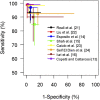Lung ultrasound for the diagnosis of pneumonia in children: a meta-analysis
- PMID: 25780071
- PMCID: PMC9923609
- DOI: 10.1542/peds.2014-2833
Lung ultrasound for the diagnosis of pneumonia in children: a meta-analysis
Abstract
Background and objective: Pneumonia is the leading cause of death of children. Diagnostic tools include chest radiography, but guidelines do not currently recommend the use of lung ultrasound (LUS) as a diagnostic method. We conducted a meta-analysis to summarize evidence on the diagnostic accuracy of LUS for childhood pneumonia.
Methods: We performed a systematic search in PubMed, Embase, the Cochrane Library, Scopus, Global Health, World Health Organization-Libraries, and Latin American and Caribbean Health Sciences Literature of studies comparing LUS diagnostic accuracy against a reference standard. We used a combination of controlled key words for age <18 years, pneumonia, and ultrasound. We identified 1475 studies and selected 15 (1%) for further review. Eight studies (765 children) were retrieved for analysis, of which 6 (75%) were conducted in the general pediatric population and 2 (25%) in neonates. Eligible studies provided information to calculate sensitivity, specificity, and positive and negative likelihood ratios. Heterogeneity was assessed by using Q and I(2) statistics.
Results: Five studies (63%) reported using highly skilled sonographers. Overall methodologic quality was high, but heterogeneity was observed across studies. LUS had a sensitivity of 96% (95% confidence interval [CI]: 94%-97%) and specificity of 93% (95% CI: 90%-96%), and positive and negative likelihood ratios were 15.3 (95% CI: 6.6-35.3) and 0.06 (95% CI: 0.03-0.11), respectively. The area under the receiver operating characteristic curve was 0.98. Limitations included the following: most studies included in our analysis had a low number of patients, and the number of eligible studies was also small.
Conclusions: Current evidence supports LUS as an imaging alternative for the diagnosis of childhood pneumonia. Recommendations to train pediatricians on LUS for diagnosis of pneumonia may have important implications in different clinical settings.
Keywords: practice management; pulmonology; respiratory tract; standard of care.
Copyright © 2015 by the American Academy of Pediatrics.
Conflict of interest statement
Figures



References
-
- World Health Organization. Pneumonia. Fact Sheet No. 331. Available at: www.who.int/mediacentre/factsheets/fs331/en/. Accessed August 1, 2014
-
- Gereige RS , Laufer PM . Pneumonia [published correction appears in Pediatr Rev. 2014;35(1):29]. Pediatr Rev. 2013;34(10):438–456 - PubMed
-
- Prayle A , Atkinson M , Smyth A . Pneumonia in the developed world. Paediatr Respir Rev. 2011;12(1):60–69 - PubMed
-
- Schlaudecker EP , Frenck RW Jr . Adolescent pneumonia. Adolesc Med State Art Rev. 2010;21(2):202–219, vii–viii - PubMed
Publication types
MeSH terms
Grants and funding
LinkOut - more resources
Full Text Sources
Medical

